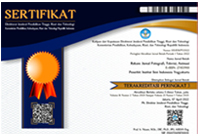Realisme Magis Imaji ke Imajinasi Visual Fotografi
Abstract
Berbagai imaji dan imajinasi yang dialami secara pribadi adalah inspirasi yang terasa familiar dan mudah diselami dalam melahirkan suatu proses ide yang kreatif, yang dalam hal ini adalah menciptakan karya seni fotografi yang estetis. Berawal dari pengalaman pribadi yang kala itu tumbuh di tengah kaum urban di pusat niaga Kota Yogyakarta, yaitu kawasan Malioboro dan kebetulan pada masa dewasa lalu berkecimpung di dunia fotografi, muncullah inspirasi untuk menciptakan karya fotografi seni tentang Malioboro. Tujuan dari artikel ini adalah untuk memaparkan bagaimana proses kreatif dalam menciptakan karya fotografi, yang pada akhirnya akan memberikan konstruksi makna yang baru terhadap visual fotografis. Karya fotografi yang secara umum diakui keotentikan realitasnya, terkadang justru melebihi realitas itu sendiri. Sebagai kerangka teoretis, realisme magis dapat melampaui dan bahkan melepaskan diri dari realitas yang ada sehingga membuka ruang pluralitas yang luas. Metode observasi, eksplorasi, dan eksperimentasi dipadukan dengan teknik digital imaging berupa visual kolase dan montase menjadikan karya fotografi tentang kawasan Malioboro bernilai seni dan estetis. Penciptaan karya ini tidak sekadar membahas tentang tataran teknis yang membentuknya, akan tetapi lebih tentang estetika dan rekonstruksi makna yang kemudian muncul. Dengan menggunakan pendekatan realisme magis dalam membuat konsep karya fotografi, hadirlah karya foto seni yang representatif dan estetis dalam menggambarkan pluralitas yang ambigu dalam keseharian di kawasan Malioboro.
Various images and imaginations that are personally experienced is an inspiration that feels familiar and easy to explore in incubating a creative process of ideas, which in this case is to create aesthetic photographic artwork. Starting from personal experiences that was raised in the middle of urban community in the commercial center of Yogyakarta, namely Malioboro area, and later when growing up happened to be engaged in the field of photography, triggered an inspiration to create art photography about Malioboro. The purpose of this article is to describe how the creative process of creating photographic works will eventually give the construction of new meaning to photographic visuals. Photography works that are generally recognized for their authenticity of reality, sometimes even exceed reality itself. As a theoretical framework, magical realism can transcend and even break away from existing realities, thus opening up a vast space of plurality. The methods applied were observation, exploration, and experimentation combined with digital imaging techniques in the form of visual collages and montages, in order to make photographic works about Malioboro area become valuably artistic and aesthetics. The creation of this photography work no longer speaks of the technical state that shaped it, but rather about the aesthetics and reconstruction of the meaning that exists in it. By using magical realism as the approach in conceptualizing the photographic works, there is a representative and aesthetic work of art in describing ambiguous plurality in everyday life in Malioboro area.
Keywords
Full Text:
PDFReferences
Arsita, Adya, Edial Rusli, Pamungkas Wahyu Setiyanto. (2021). Magical Realism: Rethinking Malioboro Through Photographs. Proceedings of the 4th International Symposium of Arts, Crafts & Design in South East Asia (ARCADESA). https://doi.org/http://dx.doi.org/10.2139/ssrn.3807627
Arsita, A. (2016). Realisme Magis dalam Kajian Visualisasi Bahasa pada Novel Grafis ‘The Photographer : Into War-Torn Afghanistan, with Doctors without Borders’ [Sekolah Pascasarjana Universitas Gadjah Mada]. http://etd.repository.ugm.ac.id/index.php?mod=penelitian_detail⊂=PenelitianDetail&act=view&typ=html&buku_id=103853&obyek_id=4
Art Term. (n.d.). Magic Realism. Retrieved May 2, 2021, from https://www.tate.org.uk/art/art-terms/m/magic-realism
Barthes, R. (1981). Camera Lucida (T. R. Howard (ed.)). Noonday Press.
Budiarti, F., & Mahadi, K. (2015). Strategi Penataan Kawasan Malioboro Menjadi Kawasan Pedestrian. Jurnal Planesa, 6(01), 51–59. https://ejurnal.esaunggul.ac.id/index.php/planesa/article/view/2384/2056
Dermawan, A. T. (1999). Dede Eri Supria: Elegi Besar/Elegy on Magacities. Yayasan Seni Rupa AiA Art Foundation.
Faris, W. B. & L. P. Z. (1995). Magical Realism: Theory, History Community Illustrated Edition. Duke University Press Books.
Ghazanfari, G. (n.d.). Ghazaleh Ghazanfari: Magical Realism. Dodho Magazine. https://www.dodho.com/ghazaleh-ghazanfari-magical-realism/
Jameson, F. (1986). On Magic Realism in Film. Critical Inquiry, 12(2), 301–325. https://www.jstor.org/stable/1343476
PM., Laksono, Nugroho Wisnu Broto, Kirik Irtanto, T. R. dan G. (2000). Permainan Tafsir: Politik Makna di Jalan pada Penghujung Orde Baru. Insist Press dan Pustaka Pelajar (Anggota IKAPI).
Rusli, E. (2016). Imajinasi Ke Imajinasi Visual Fotografi. REKAM, 12(2), 95.
Smithson, A. (2017). FOCUS ON COLLAGE: PAULA GILLEN. http://lenscratch.com/2020/11/collage-paula-gillen/
Stotzer, T. (2005). Photography in Madagascar: Magical realism as an ambiguous space [Edit Cowan University]. In repository. https://doi.org/10.1057/978-1-349-96042-2_425
Usman, S. (2006). Malioboro. PT Mitra Tata Persada.
DOI: https://doi.org/10.24821/rekam.v18i1.6904
Article Metrics
Abstract view : 0 timesPDF - 0 times
Refbacks
- There are currently no refbacks.

This work is licensed under a Creative Commons Attribution 4.0 International License.



